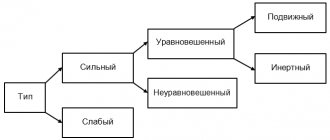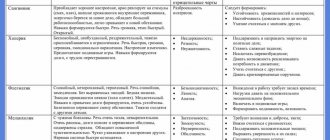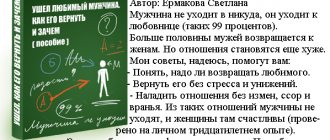As a rule, temperament is inherited by a child from one of the parents; also, in the process of upbringing, some character traits are adopted, which can be strengthened.
Articles on the topic
- Social adaptation of convicts: specifics of the activities of special institutions 01/19/2022
- Intercultural adaptation is the basis for successful life abroad 01/17/2022
- Poor parenting and its impact on human behavior 08/24/2021
- What does a femme fatale mean and how does she differ from a bitch 06.24.2021
Theory of temperament according to Hippocrates and Galen
Four temperaments in the form of visual emoticons (names from left to right and top to bottom: phlegmatic, choleric, sanguine, melancholic)
The magic of numbers in the Mediterranean civilization led to the doctrine of the four temperaments, while in the East a five-component “world system” developed.
The word “temperament” (from Latin peramentum) translated from Latin means “stable mixture, ratio of parts”; the Greek word “krasis” (ancient Greek κράσις, “fusion, mixing”), which is equal in meaning to it, was introduced by the doctors of antiquity Hippocrates and Galen. They suggested that there are stable individual differences in the relationships between chemical systems that regulate human behavior. Despite the fact that Hippocrates was among the first to point out the role of the brain in the general regulation of behavior, he attributed the most stable individual differences to differences in mixtures of neuro-humoral body fluids. Hippocrates suggested, and Galen explained temperament in more detail as behavioral characteristics, the predominance in the body of one of the “vital juices” (four elements):
- The predominance of lymph (ancient Greek φλέγμα, phlegm
, “phlegm”) makes a person calm and slow -
phlegmatic
. - The predominance of yellow bile (ancient Greek χολή, chole
, “bile, poison”) makes a person hysterical and boorish, “hot” -
choleric
. - The predominance of blood (Latin sanguis, sanguis
,
sangua
, “blood”) makes a person active and cheerful -
a sanguine person
. - The predominance of black bile (ancient Greek μέλαινα χολή, melena chole
, “black bile”) makes a person sad and fearful -
melancholic
.
Temperaments: a sketch of statues of the 17th century, part of the Grande Commande, by Charles Lebrun
People with pronounced traits of a certain temperament are not very common; most often people have mixed temperament in various combinations. But the predominance of traits of any type of temperament makes it possible to classify a person’s temperament as one or another type. One of the most common classifications of temperament types in Russian literature:
Choleric
- fast, impetuous, but completely unbalanced, with sharply changing moods with emotional outbursts, quickly exhausted. He does not have a balance of nervous processes, this sharply distinguishes him from a sanguine person. A choleric person has a tremendous capacity for work, however, when he gets carried away, he carelessly wastes his strength and quickly becomes exhausted.
Phlegmatic person
- unhurried, unperturbed, has stable aspirations and mood, outwardly stingy in the manifestation of emotions and feelings. He shows perseverance and perseverance in his work, remaining calm and balanced. He is productive at work, compensating for his slowness with diligence.
Sanguine
- a lively, hot-tempered, active person, with frequent changes of impressions, with a quick reaction to all the events happening around him, quite easily coming to terms with his failures and troubles. Usually a sanguine person has expressive facial expressions. He is very productive at work when he is interested. If the work is uninteresting, he treats it indifferently and becomes bored.
Melancholic
- prone to constantly experiencing various events, he reacts sharply to external factors. He often cannot restrain his asthenic experiences by force of will; he is highly impressionable and emotionally vulnerable.
This concept still influences literature, art and science. Types of temperament played an important role in the psychology of modern times, in the philosophy of Immanuel Kant and Rudolf Hermann Lotze. The reason for the persistence of the Hippocratic-Galen theory may be that they were the first to describe four types of behavior that are truly associated with imbalances in neurotransmitter (neurochemical) systems, which, when imbalanced in extremes, manifest as psychiatric profiles. These profiles have been recognized by humanity for more than 2,500 years and are reflected in the international classifications of psychiatric diseases (DSM or ICD). Below is a list of borderline states that are observed with pronounced temperament.
| Types according to Hippocrates-Galen | Temperament Traits | ICD-10 diagnoses | ICD-10 codes † |
| Choleric | Impulsivity, aggression | Impulsive personality disorder | F60.30 |
| Phlegmatic person | Socially withdrawn, self-absorbed | Schizoid personality disorder | F60.1 |
| Melancholic | Sad, fearful, depressed, weak | Anxious personality disorder | F60.6 |
| Sanguine | Active, social, self-confident | Hypomania | F30.0 |
Origins
Historically, in the second century AD, the physician Galen described four temperaments (melancholic, phlegmatic, sanguine and choleric) based on the four humours, or bodily fluids. These became known as the four classical temperaments. In later history, Rudolf Steiner emphasized the importance of the four classical temperaments in elementary education, at a time when he believed that the influence of temperament on personality was strongest.
Neither Galen nor Steiner are generally applied to the modern study of temperament in the approaches of modern medicine or modern psychology.
Hippocrates' teaching on types of temperament
Hippocrates (an ancient Greek physician) understood temperament as the anatomical, physiological and individual psychological characteristics of an individual. Hippocrates, and later Galen, spoke of temperament as the behavioral characteristics of an individual in whose body one of the four “vital juices” is predominant.
- In choleric people, yellow bile (“bile, poison”) predominates, which makes him impulsive and uncontrollable.
- In phlegmatic people, lymph (“phlegm”) predominates, which makes a person calm, calm, and slow.
- In sanguine people, blood (“blood”) predominates, which makes him cheerful and active.
- In melancholic people, black bile (“black bile”) predominates, which makes him timid, fearful, and sad.
additional literature
- Great Soviet Encyclopedia: In 30 volumes - M.: “Soviet Encyclopedia”, -.
- Chess., S. (1997). Temperament: Theory and Clinical Practice. Harvard Mental Health Letter, 14(5), 5-7.
- Davidson, D. A. (2005). Psychosocial Issues Affecting Social Participation. In J. Case-Smith (Ed.), Occupational Therapy for Children (pp. 449–480). St. Louis: Elsevier Mosby.
- Maziade, M. (1983). Le tempérament de l'enfant, les différences individuelles et les forces environnementales. Santé mentale au Québec, 8(2), 61-67.
- Olson, L. J. (1999). Psychosocial Frame of Reference. In P. Kramer & J. Hinojosa (Eds.), Frames of Reference for Pediatric Occupational Therapy (pp. 323–375). Philadelphia: Lippincott Williams & Wilkins.
- Zeanah, C. H., & Fox, N. A. (2004). Temperament and Attachment Disorders. Journal of Clinical Child & Adolescent Psychology, 33(1), 32-41.
Modern theories of temperament
The modern interpretation of the doctrine of temperaments differs only in the statement that every person has all types of temperament, but with a predominance of one of them. However, scientists are more inclined to consider the dependence of human behavior on the type of figure than on the interaction of internal fluids.
A group of Western European scientists at the turn of the 19th and 20th centuries put forward a theory of the relationship between temperament and the constitutional features of the structure of an individual’s body. For example, the German psychiatrist Kretschmer put forward the idea that mental illness is associated with the constitutional features of the structure of the body:
- Asthenics - fragile, angular physique; the author of the theory proposes to call them leptosomatics.
- Pickwick is a man of large build, sometimes with a barrel-shaped figure. Distinguished by stooping.
- Athletic is a muscular type without a pronounced layer of fat. Features a wide shoulder girdle with narrow hips.
- Dysplastic is characterized by an irregular physique. For example, he is too tall or short.
Kretschmer concluded from his observations of psychotypes that asthenics are prone to schizophrenia, and athletes are prone to epilepsy.
Later, the American psychologist and scientist V. Sheldon distinguishes three somatic types depending on the constitutional features of the body structure:
- endomorphic;
- mesomorphic;
- ectomorphic.
The endomorphic type is characterized by the presence of a large fat layer and excessive development of internal organs. These individuals appear physically undeveloped and weak.
The mesomorphic type belongs to the athletic body structure and is distinguished by developed muscles instead of a fat layer. These individuals, as a rule, have good health, strong will and cheerfulness.
The ectomorphic type is characterized by the absence of fat and muscle, as well as the unexpressed development of internal organs. These individuals are easily excitable, impressionable and vulnerable.
Sheldon claims that there is another, fourth type of temperament: mixed. However, according to his observations, this type is extremely rare.
Further, Sheldon proposed combining a person's introverted and extroverted qualities with his physique, as a result of which he identified 3 personality types:
- viscerotonics;
- somatotonics;
- Cerebrotonics.
Viscerotonics are distinguished by a predominance of internal feelings, somatotonics show their temperament in activity and action, cerebrotonics prefer analytics and reflection to action.
Despite the emphasis on somatic features in the theory of the essence of personality, the fluid idea of the mental manifestations of the individual remains valid. Therefore, the teachings of Hippocrates and his followers still remain fundamental in theories about the essence of man and his mental characteristics.
Spreading concept
For almost a millennium and a half, the Western art of healing has been based on this indisputable foundation. In the Middle Ages, the humoral quadripartite scheme reached its apogee.
Character and temperament
One thing has remained unchanged over the centuries. Simply put, all problems of the body are explained by the predominance of body juices and, therefore, temperament. According to the concept of counteraction, juices and temperaments, pharmacopoeias indicate how and with the help of which substances the disturbed balance can be restored.
Now the theory is considered outdated, but in the Middle Ages it was a progressive explanation of processes occurring at the physical and mental level.
Theories of temperament of the 20th century abroad
From the point of view of psychology, the four temperaments are only one of the possible systems for assessing psychological characteristics (there are others, for example, Jung’s types, “introversion - extraversion” by Hans Eysenck). Descriptions of temperaments vary quite a bit among different psychologists and seem to include a fairly large number of factors. Attempts have been made to provide a scientific and experimental basis for the theory of temperaments (I. P. Pavlov, G. Yu. Eysenck, B. M. Teplov and others), however, the results obtained by these researchers are only partially compatible with each other. Blyumina (1996) and Trofimova attempted to compare the theory of temperaments with all psychological typologies known at that time (more than 100), including from the point of view of methods for determining these types. Modern science sees in the doctrine of temperaments an echo of the ancient classification of four types of mental response in combination with intuitively noticed types of physiological and biochemical reactions of the individual.
Many psychologists, as proposed by Kant at the end of the 18th century, Heymans at the beginning of the 20th century and G. Yu. Eysenck in the 1960s, divide the components of temperament into 2 groups: “Activity” of behavior and “Emotionality”. Activity of behavior is characterized by the degree of energy, swiftness, speed, or vice versa, slowness and inertia. In turn, emotionality characterizes the course of emotional processes, determining the sign (positive or negative) and modality (joy, grief, fear, anger, etc.).
Gray, who analyzed the work of Russian psychologists in the field of temperament, proposed a 2-dimensional model in which 4 Hippocratic types were placed on the scales of the Behavior Activation System and Behavior Inhibition System. The ratio of “high” and “low” levels, for each of these two independent parameters, gives a certain individual characteristic of a person, and, as a result, a formal definition of each of the four temperaments. On emoticons (see picture above) you can interpret a smile as the ease of inhibition processes, and frowning eyebrows as a manifestation of ease of excitement.
Abroad, the main research in the field of temperament was carried out in the fields of child psychology (Buss & Plomin, 1984; Chess & Thomas, 1996; Kagan & Snidman, 2009; Rothbart et al, 2000; Windle & Lerner, 1986), clinical psychology and psychiatry (Akiskal , 1998; Cloninger, 1986, 1994; Mehrabian, 1996; Panksepp et al, 1987; Zuckerman, 1994). In relation to adult temperament, this concept has been merged overseas with the concept of personality, and has been analyzed as “biologically based personality traits” (Cattel, 1965; Digman & Takemoto-Chock, 1981; Goldberg 1993; Guilford & Zimmerman, 1956; McCrae & Costa 1997 ; Norman, 1963). Such a fusion is not recommended, since the concept of personality refers to socio-cultural processes, values, attitudes, personal experiences, self-esteem and the range of a person's relationships with other people, while temperament, according to the initial definition, refers to the neuro-chemical balance of the body.
Introduction.
Psychology is a very important subject in the field of social understanding, since we use many elements of psychology in life every day. In order to understand what kind of person is standing in front of you, you need to have a minimal understanding of his psyche and the psyche of his behavior. Some conclusions come from the subconscious, which allows us to make a preliminary assessment of a person. But as we know, “first impressions are often deceiving.” Psychology gives us a slightly greater chance of not making a mistake about what kind of person is in front of us.
The first thing you can often notice about people is how they behave in front of others and how they react to them. This is characterized by a person's temperament.
In this work, I set myself a goal - to find out about temperament, its types and characteristics.
I set myself the following tasks:
- Expand the concept of temperament
- Understand the types of temperaments
- Find out how to determine your temperament
- Find out at what age temperament is formed
- Understand how temperament can affect the people around you and the person himself
At the end of the analysis, I want to find out whether temperament is the primary aspect by which a person should be understood and judged, or whether it is one of those factors of an individual that shows part of his shell, and not the inner content as a whole.
Doctrine of Temperament
Temperament is the biological basis that is the basis for the formation of an individual as a social unit. In other words, this is a set of behavioral reactions caused by the characteristics of organic processes within the body. Temperament is not acquired during human life; it is given from birth. A person, in the process of his life activity, gets to know himself as a person, gets acquainted with the characteristics of his reactions to the surrounding reality, but does not control these reactions and does not create them.
Note! Temperament, translated from ancient Greek, means correct measure and proportionality. The ancient Greek scientist and healer Hippocrates, whose oath every physician takes after completing his studies at the institute, made a lot of efforts in understanding the essence of man and his behavioral characteristics
In the course of numerous experiments and reflections, the scientist came to the conclusion that the reaction to what is happening is due to the influence of fluids inside the body
The ancient Greek scientist and healer Hippocrates, whose oath every physician takes after completing his studies at the institute, made a lot of effort in understanding the essence of man and his behavioral characteristics. In the course of numerous experiments and reflections, the scientist came to the conclusion that the reaction to what is happening is due to the influence of fluids inside the body.
The scientist considered the following to be vital juices:
- blood;
- bile (black and yellow);
- phlegm (mucus).
For example, blood warms up the human body and is a source of heat. Phlegm cools the body, yellow bile dries out the internal media, black bile is responsible for the level of humidity in the internal media of the body.
Thus, Hippocrates laid the foundation for the study of the essence of man and its characteristics in direct connection with biological processes.
The followers and students of Hippocrates continued to develop the doctrine of temperaments: Claudius Gallen defined the typology of temperaments. Subsequently, the types of temperament according to Hippocrates and Gallen were called humoral. Further development of the theory was continued by the German philosopher Immanuel Kant; he gave an accurate description of the four human temperaments:
- sanguine;
- choleric;
- phlegmatic person;
- melancholic.
Kant also clarified that the reactions of sanguine and melancholic people are caused by feelings and emotions, and the reactions of choleric and phlegmatic people are generated by the sphere of human activity. In accordance with this, choleric and phlegmatic people are distinguished by activity in their manifestations, and sanguine and melancholic people are characterized by emotionality.
Characteristics of human temperaments according to Hippocrates:
- The choleric type of temperament is controlled by yellow bile.
- Sanguine people have a large volume of blood.
- The melancholic is controlled by black bile.
- The body of a phlegmatic person is filled with cold mucus.
Characteristics of temperaments according to Kant:
- Sanguine people are cheerful and carefree.
- A melancholic person exhibits anxiety and a gloomy mood.
- The choleric person quickly lights up and quickly cools down to the subject of his interest.
- A phlegmatic person shows coldness and indifference, and is distinguished by laziness.
Methodology
You may be interested in: Distance education in Russia: history, statistics and advantages
Temperament is defined through specific behavioral profiles, usually focusing on those that are easily measured and tested in early childhood. Commonly tested factors include traits related to energy abilities (called Activity, Endurance, Extraversion), traits related to emotionality (such as irritability, frequency of smiling), and approach or avoidance of unfamiliar events.
Typically, there is a low correlation between teachers' descriptions and scientists' behavioral observations of traits used in defining temperament. It is assumed that temperament is associated with biological factors, but these turned out to be complex and varied, never bringing clarity to the Hippocratic classification.
Russian studies of temperament
The Russian tradition of studying temperament began in 1906, with studies of the types and properties of the nervous system in the school of Ivan Petrovich Pavlov and continued in the studies of the Laboratory of Differential Psychophysiology at the Institute of Psychology, the Russian Academy of Sciences, in the studies of B. M. Teplov (1963), V. D. Nebylitsyna (1972), and then V. M. Rusalova (1979).
- The weak type is characterized by weakness of both excitatory and inhibitory processes - corresponds to the Hippocratic melancholic.
- The strong unbalanced type is characterized by a strong irritability process and a relatively weak inhibition process - corresponds to the choleric, “uncontrollable” type.
- A strong, balanced, mobile type - corresponds to the sanguine, “living” type.
- Strong, balanced, but with inert nervous processes - corresponds to the phlegmatic, “calm” type.
B. M. Teplov gives another definition of temperament: “Temperament is a characteristic set of mental characteristics for a given person associated with emotional excitability, that is, with the speed of the emergence of feelings, on the one hand, and strength, on the other.”
Nebylitsyn and Rusalov considered temperament, just like Pavlov, as formal-dynamic properties of behavior - energetic (such as endurance), dynamic (speed of act integration - mobility, tempo), as well as emotionality. In their laboratory at the Institute of Psychology of the USSR Academy of Sciences, EEG measurements, evoked potentials, caffeine tests, studies of absolute thresholds of perception in visual, auditory and tactile modalities, strength of excitation and mobility in auditory and visual modalities, efficiency of problem solving in certain (deterministic) and uncertain (probabilistic) conditions, and the speed of performing various tests. Rusalov showed that temperamental traits regulating different types of activity have different psychophysiological correlates, that is, specificity depending on the type of activity.
Based on these studies, the Activity-Specific Approach to the structure of temperament was proposed. This approach proposes to separate traits related to three specific aspects of performance - physical, social-verbal and mental. This idea was first voiced by V.D. Nebylitsyn. This approach was then developed on a full scale in differential psychology and psychophysiological experiments in the 1970s–1990s by Rusalov, a successor to Nebylitsin’s laboratory.
After Rusalov proposed an activity-specific structure of temperament, Trofimova, who did her PhD in his laboratory, developed this approach and proposed her own version based on Rusalov's model in the form of the Compact version of the Temperament Structure Questionnaire (STQ-77).
Because this approach was developed in adult temperament research, it has not been common in child psychology in the West (where temperament theory is primarily associated with individual differences in children). In contrast to this approach, all other temperament models also include “energy” traits (eg, Activity or Extraversion), but do not distinguish between energetic trait types related to the regulation of these three specific aspects of behavior. The idea of a temperament structure that distinguishes traits regulating different types of activity was taken as the basis for the neuroimage model Functional Ensemble of Temperament, which describes the role of monoamine neurotransmitters, neuropeptides and hormones in the regulation of 12 temperament traits.
Psychological characteristics of the main types of temperament
Temperament concept
Temperament is a set of individual characteristics of a person that characterize the emotional and dynamic side of his activity (mental activity and behavior). Certain properties and characteristics of temperament can favor or counteract the formation of personality traits.
From a physiological point of view, temperament is determined by the type of higher nervous activity of a person (type of HNI).
Depends on a person's temperament
- Assessment and control of activities.
- The speed of occurrence of mental processes (speed of thinking, perception, duration of concentration).
- Intensity of mental processes (activity of the will, strength of emotions).
- Pace, rhythm and acceleration of activity.
- Disciplinary actions.
- The direction of mental activity towards certain objects (extraversion or introversion).
Doesn’t apply to a person’s temperament type
- Character – determines how a person acts, acquired, subject to change.
- Abilities - determine with what speed, depth, ease and strength he masters knowledge, skills and abilities.
Temperament forms the basis for the development of a person’s character and influences the way a person communicates and behaves.
Temperament is an innate individual characteristic of a person; it is not subject to change. A person with any type of temperament may or may not be capable. The type of temperament does not affect a person’s abilities, it’s just that some life tasks are easier to solve by a person of one type of temperament, others - by another.
Adults involved in raising and educating a child must take into account the type of temperament of the child so that the methods and techniques used in upbringing and teaching are effective and do not harm the child.
What is temperament
Temperament is a set of genetically determined mental qualities of a person, which depend on the characteristics of higher nervous activity. That is, this is an innate property of the psyche that a person cannot change. However, a person is able to successfully “disguise” or “smooth out” some qualities of his temperament. However, in stressful situations (including the effect of surprise), it is the innate quality that is more likely to manifest itself, rather than the acquired one.
By the way, not only people have temperament, but also some animals. These include dogs, cats, monkeys, horses, dolphins, etc. Human and animal temperament types are similar in many ways, but in humans they are more complex and deeper.
4 main types of temperament - choleric, sanguine, phlegmatic, melancholic. There is also a fifth temperament - ambivert, which includes people who do not have pronounced qualities of other temperaments, that is, they are always somewhere in the middle.
But now the main focus is the relationship between these properties in the individual’s psyche. In nature, there are no people with one type of temperament. All 4 types can coexist in the same person. However, 1-2 of them will be dominant. What does it mean?
For example, there is a person who is 50% sanguine, 30% melancholic, 15% phlegmatic and 5% choleric. This is a provisional calculation, since it is impossible to establish an exact percentage. Obviously, the dominant type is sanguine, and in most life situations a person will behave according to the sanguine temperament. However, in some cases, a melancholic person may appear, which will temporarily and partially overshadow the dominant type. Phlegmatic and choleric people will also appear periodically, but rarely and for a short time. Our test will help you determine your propensity for a particular temperament.
But it is impossible to say exactly at what moment this or that psychotype decides to become active. There are several assumptions:
- one type of temperament is replaced by another when the first one fails to cope with the situation. For example, if something threatens the life of a phlegmatic person, he may suddenly discover a choleric person in himself;
- a change in activity occurs due to severe or prolonged stress. After her husband’s betrayal, a choleric woman withdraws into herself and allows her inner melancholic to emerge;
- different types are activated in different areas of life. For example, in work matters he is choleric, in relationships he is sanguine.
However, all these properties do not appear out of nowhere. If some type of temperament is not initially inherent in an individual, it will never appear. A person can pretend to be choleric/sanguine/phlegmatic/melancholic, but will never truly become one. That is, a melancholic person will be afraid to try new things, no matter how hard he tries to seem brave. And the phlegmatic person will continue to carry out work assignments slowly but thoughtfully, even if the deadline has already arrived and is looking at him menacingly.
Sanguines
The word comes via French from the Italian sanguigna and originally from the Latin "sanguis" (red chalk). Each of the 4 types of Hippocratic classification is named after a substance, so do not be surprised at such a strange etymology.
The pigment used in sanguine sticks comes from red earth such as red ochre. Sanguine (chalk red) can also exist in several other colors such as orange, brown, brown, beige.
Four types of temperament
The ancient Greek physician Hippocrates created a theory dividing people into 4 psychotypes, depending on the fluid predominant in their body. These are blood, lymph (mucus), bile and black bile. He also coined the term temperament.
Sanguines.
In people of this type, blood dominates in the body, which makes them cheerful and sociable. They easily adapt to new surroundings and make acquaintances without difficulty. They can easily switch from one type of activity to another, but a routine activity will seem boring to them. Their emotions are constantly changing. The mood is the same, but more often it is cheerful and cheerful. Sanguine people have loud, clearly articulated speech, accompanied by emotional gestures.
Phlegmatic people.
In the body of this psychotype, lymph predominates. At first glance, phlegmatic people may seem lazy and indifferent, but in reality they are simply leisurely and balanced.
They are persistent in their work and bring any task to the end.
When communicating with people they do not show excessive emotions and treat all events calmly. Phlegmatic people are difficult to unbalance and hurt their feelings. But they should be more active in life so as not to turn into individuals who are indifferent to everything that happens.
Cholerics.
The predominant fluid of this type is bile. They are too emotional, sometimes even unbalanced. Cholerics are characterized by: irritability, impulsiveness, short temper, sharp gestures, rapid speech. They clearly express their feelings, their mood is unpredictable.
Usually choleric people take on work with pleasure and quickly complete it. But their energy supply is quickly spent, and they become lethargic and indifferent to the work done.
In communication they can be harsh and irritable, which often leads to conflicts.
Melancholic people.
Black bile defines this type of temperament. Melancholic people often react inappropriately and aggressively to external stimuli. They are touchy, perceive conflict situations with difficulty, but hide their feelings.
They approach work passively and most often do not show initiative. But they are not afraid of monotonous activities; in a calm atmosphere they are very efficient.
They feel awkward in unfamiliar places and are embarrassed when communicating with new people. Melancholic people are withdrawn and prefer loneliness.
Of course, there are no 100% choleric, phlegmatic, sanguine and melancholic people. Every person has something of each type. But the predominant qualities determine the temperament of a person.
How to determine your personality type
Determining your personality type is quite simple. To do this, you can use different methods and tests. In addition, to save effort and time, you can take them online. The main goal of such questionnaires is to understand exactly how a person will react to a particular situation.
To obtain objective results, psychologists recommend giving quick and clear answers. You don’t need to think a lot about solving this or that issue, you need to act depending on the emotions that arise first
It is worth noting that there are no right or wrong questions in such tests. There is no good or bad answer here.
Melancholic people can only work in a calm and familiar environment
Biography
Hippocrates
Hippocrates received his initial medical education from his father, the physician Heraclides. For the purpose of scientific improvement in his youth, Hippocrates traveled a lot and studied medicine in different countries from the practice of local doctors and from votive tables that were hung in the walls of the temples of Asclepius.
- “The doctor is a philosopher; for there is not much difference between wisdom and medicine.” Hippocrates
The story of his life is little known; it is not even known exactly how many years Hippocrates lived. Some historians claim that he was 83 years old, while others say that he was 104. There are legends and stories relating to his biography, but they are of a legendary nature.
Hippocrates died around 370 BC. e. in Larissa, in Thessaly, where a monument was erected to him, but for thousands of years the “Hippocratic Oath” became the code of professional honor for all doctors.









